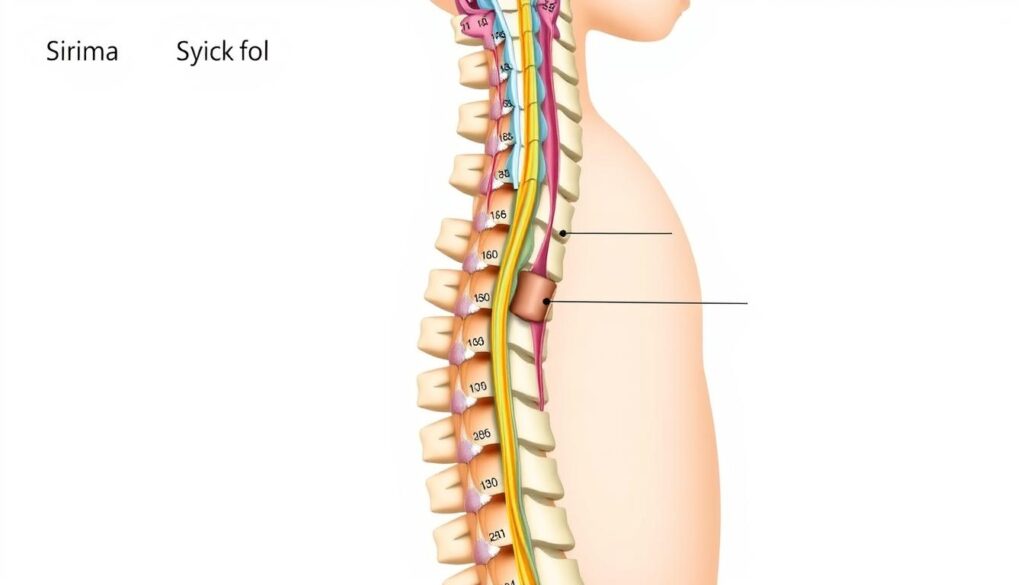Spina bifida is a complex neural tube defect affecting thousands of families yearly. It occurs when the spinal cord and surrounding tissues don’t develop properly during early pregnancy1. In the U.S., about 1,500 babies are born with this condition annually.
This congenital disability varies in severity. Some people experience minimal symptoms, while others need extensive medical care. Folic acid deficiency during pregnancy is thought to contribute to its development2.
Doctors stress the importance of early detection and comprehensive care. Around 70,000 people in the U.S. live with spina bifida2. With proper medical support, individuals can lead fulfilling lives.
Key Takeaways
- Spina bifida is a neural tube defect occurring during early pregnancy
- The condition affects approximately 1,500 babies annually in the U.S.
- Early detection and medical intervention are crucial
- Folic acid supplementation can potentially reduce risk
- Individuals with spina bifida can lead productive lives with proper care
What is Spina Bifida and Its Types
Spina bifida is a complex neural tube defect affecting newborns yearly. It happens when the spinal column doesn’t close fully during early fetal growth34. Knowing its forms helps spot signs and get proper care.
Spina bifida ranges from mild to severe. Let’s look at the main types of this hidden spinal problem.
Spina Bifida Occulta: The Mild Hidden Form
Spina Bifida Occulta is the most common and mildest type. About 10% to 20% of U.S. people have this hidden spinal defect3. Most don’t know they have it.
It rarely causes health issues or needs surgery4. Doctors often find it by chance during routine scans.
- Characterized by a small separation in spinal bones
- Often discovered accidentally during routine imaging
- Rarely requires surgical repair
Meningocele: Spinal Cord Membrane Protrusion
Meningocele is a rare type of spina bifida. The spinal cord membrane sticks out through a gap in the spine4. It forms a fluid-filled sac on the back.
This type is less severe than others5. Doctors can often fix it with little nerve damage.
| Characteristic | Details |
|---|---|
| Occurrence | Rare form of spina bifida |
| Surgical Intervention | Often can be repaired with minimal nerve damage |
Myelomeningocele: The Severe Spinal Condition
Myelomeningocele is the worst form of spina bifida. It happens in about 1 in 1,000 births3. The spinal cord and nerves stick out, often without skin cover4.
Key features of Myelomeningocele include:
- High risk of hydrocephalus (70-90% of cases)3
- Potential for Chiari malformation
- Possible paralysis or weakness in lower limbs
- Potential bladder and bowel function challenges
Early diagnosis and comprehensive treatment are crucial for managing the complexities of myelomeningocele4.
Risk Factors and Prevention of Neural Tube Defects
Neural tube defects (NTDs) can be influenced by various factors. Genetic factors play a crucial role in these conditions. Understanding these risks helps protect your pregnancy6.
- Folate deficiency during early pregnancy6
- Family history of neural tube defects7
- Uncontrolled diabetes7
- Obesity7
- Certain medications like anti-seizure drugs7
Preventing NTDs mainly involves folic acid supplementation. Taking 400 micrograms daily before and during early pregnancy can reduce risks6. Folic acid supplements may prevent up to 70% of neural tube defects7.
Proactive prenatal care is your best defense against neural tube defects.
Some women might need higher folic acid doses. Talking to a healthcare professional helps create a personalized prevention plan.
| Risk Factor | Impact on NTD Risk |
|---|---|
| Obesity | Higher risk of spina bifida7 |
| Diabetes | Increased neural tube defect probability7 |
| Folate Levels | Critical for prevention6 |
Early detection is key for a healthy pregnancy. Regular prenatal care and genetic counseling offer valuable insights. Stay informed and proactive to ensure the best outcomes.
Conclusion
Living with spina bifida calls for expert pediatric neurosurgery and continuous medical care. Personalized treatments can greatly boost your quality of life89. Doctors create unique plans to tackle specific nerve and movement challenges.
A team of specialists works together to help you reach your full potential. Mobility aids are key in supporting independence. Many people with spina bifida achieve great personal and career success8.
Genetic factors play a role in this condition. Yet, new medical approaches keep improving outcomes8. Research on neural tube defects is advancing, offering hope for future generations.
Your spina bifida journey showcases your strength and resilience. Team up with healthcare providers and use supportive tech. This combo can help you grow and become more independent910.
The future looks bright. Medical breakthroughs, thorough care plans, and a strong support system can help you thrive. Your drive, paired with ongoing research, paints a hopeful picture for better treatments.
FAQ
What exactly is spina bifida?
What are the different types of spina bifida?
What causes spina bifida?
How can spina bifida be prevented?
What are the potential complications of spina bifida?
How is spina bifida treated?
Can people with spina bifida lead normal lives?
Is spina bifida hereditary?
Source Links
- Spina bifida causes, symptoms and treatment – https://www.chop.edu/conditions-diseases/spina-bifida
- Spina Bifida – https://www.aans.org/patients/conditions-treatments/spina-bifida/
- Spina Bifida: Types, Tests, Treatment & Prevention – https://my.clevelandclinic.org/health/diseases/8719-spina-bifida
- Spina bifida – Symptoms and causes – https://www.mayoclinic.org/diseases-conditions/spina-bifida/symptoms-causes/syc-20377860
- About Spina Bifida – https://www.cdc.gov/spina-bifida/about/index.html
- Neural Tube Defects – https://www.cdc.gov/birth-defects/about/neural-tube-defects.html
- Spina bifida – Causes – https://www.nhs.uk/conditions/spina-bifida/causes/
- Spina Bifida – PMC – https://pmc.ncbi.nlm.nih.gov/articles/PMC4898641/
- Spina Bifida (Myelomeningocele) – https://fetus.ucsf.edu/spina-bifida/
- Spina Bifida: Symptoms & Causes | NewYork-Presbyterian – https://www.nyp.org/pediatrics/neurology-and-neurosurgery/spina-bifida
